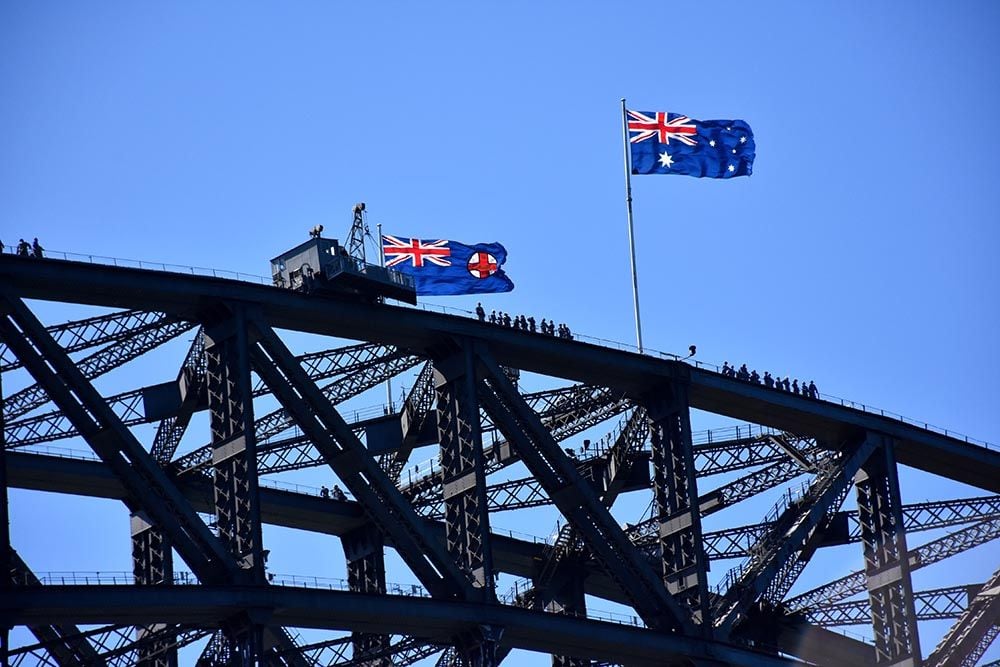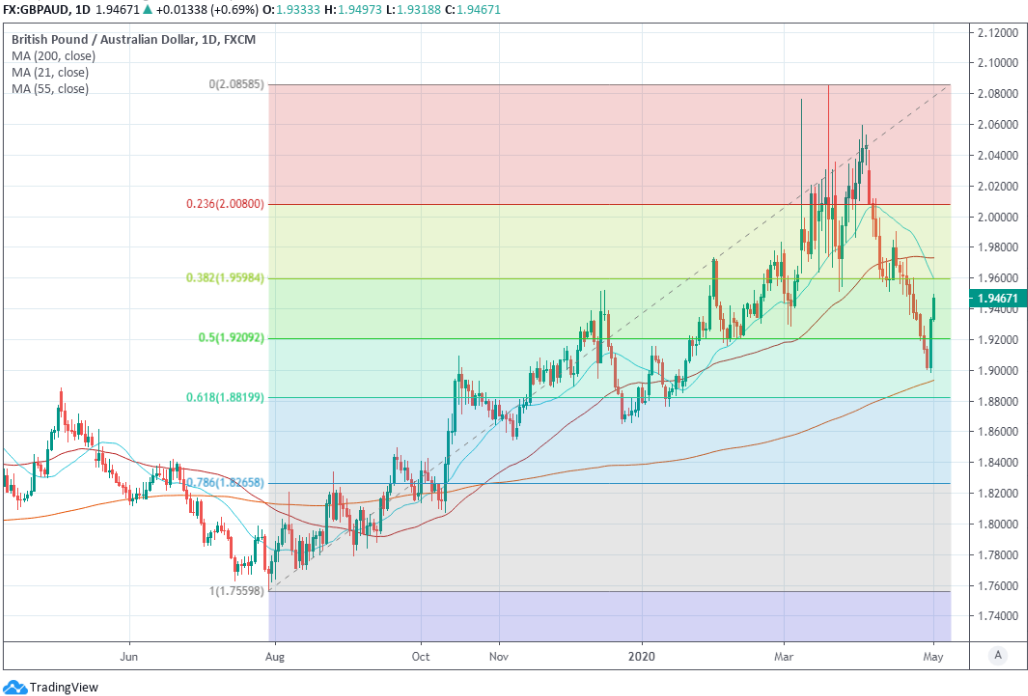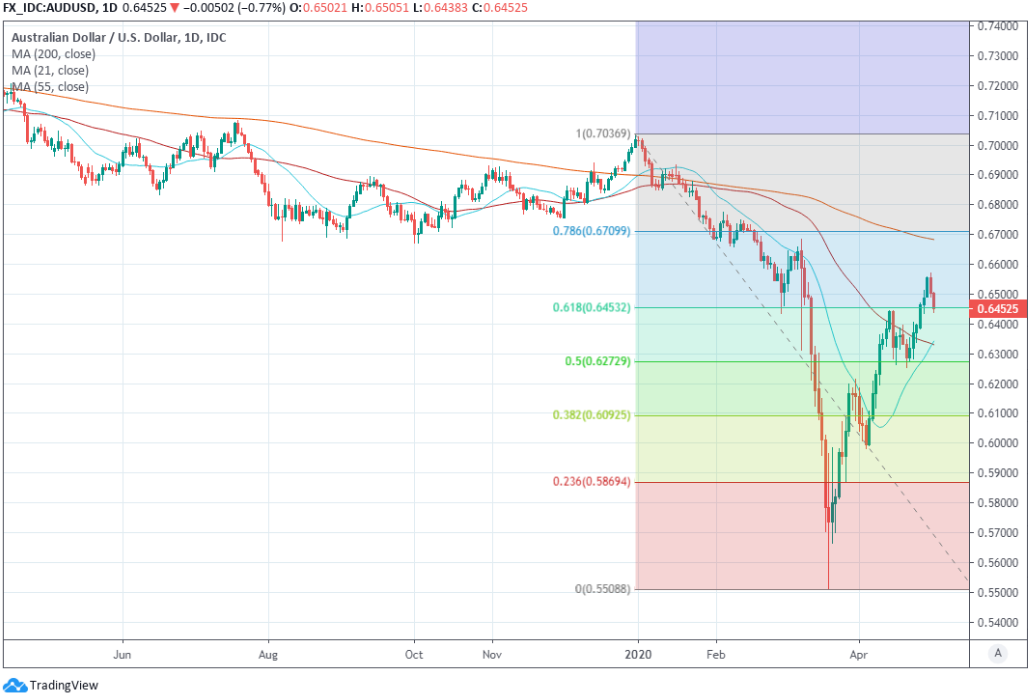Pound-Australian Dollar Rate in Recovery Mode and Can Go Further
- Written by: James Skinner
-
- GBP/AUD in recovery from 200-day average, can go further.
- BofA suggests seasonal factors could lift GBP/AUD in May.
- Westpac tips recovery as far as 1.98 on an AUD correction.
- But June's Brexit deadline could see GBP/AUD lower again.

Image © Desiree Caplas, Adobe Stock
- GBP/AUD spot at time of writing: 1.9461
- Bank transfer rates (indicative): 1.8786-1.8922
- FX specialist rates (indicative): 1.9175-1.9292 >> More information
The Pound-Australian Dollar rate was in recovery mode Friday and is tipped to climb further up ahead following a punishing April month, with much of that decline likely to be retraced, although the levels produced in this correction could be the best available to Aussie Dollar buyers for a while to come.
Pound Sterling has stabilised against the Aussie and other commodity currencies following a sell-off that took the Pound-Australian Dollar rate -8% lower from peak-to-trough before culminating in rejection by the 200-day moving-average of prices that was sitting just above 1.89 on Thursday. April was characterised by a widespread recovery of risk assets including the Aussie Dollar and stock markets but an old adage says to "sell in May and go away."
"We find that all G10 currencies broadly underperform through the month. As Chart 4 highlights, the consistency in the under-performance reveals two findings: a) AUD, NOK and other high beta currencies weaken the most; b) EUR under-performs more than GBP. This pattern of FX performance strongly suggests that May is a risk-off month," says Kamal Sharma, a strategist at BofA Global Research. "FX volatility (using the JPM VXY index as a proxy) rises on average and has done so particularly in the last couple of years."
Above: BofA Global Research graphs showing seasonal performances of G10 currencies for month of May.
The May month leaves behind the opening of a new tax year and all of the related financial flows that can help to lift risk assets and is often seen weighing on markets. Sterling is a risk asset, with an average -2.3% decline against the U.S. Dollar each year since 2010 according to BofA Global Research, although the Aussie also tends to suffer even more which means the coming weeks may see the upside correction in Pound-Australian Dollar rate extend.
Westpac also seems to agree.
"The RBA and BoE are pursuing very expansionary monetary policy and fiscal support is substantial, especially in Australia. Australia’s C/A position is much more supportive and Australia’s much lower Covid-19 case count should mean a quicker restarting of economic activity in Australia. These factors should ensure AUD remains well above March lows but given our baseline view on global risk appetite, we see AUD softening to GBP 0.5050/0.5100 or AUD 1.96-1.98 multi-week," says Westpac's Sean Callow.
There's another adage that's also still popular with investors and which could become increasingly relevant this month; "buy the rumour and sell the fact." May will increasingly see major economies across Europe and North America taking steps to lift 'lockdown' measures in place when the spread of coronavirus appeared to have been succesfully curtailed, but investors may already have squeezed the last drops from that narrative and for some it may soon seem like time for economies to actually deliver some goods.
There's also the prospect of fresh tensions between the U.S. and China. An Australian point of view on this is also increasingly being heard.
Above: GBP/AUD at daily intervals with Fibonacci retracements of 2020 downtrend and selected moving-averages.
Quite how quickly the global economy heaves itself up out of the coronavirus trough remains to be seen although many economists and analysts are sceptical of the earlier idea that the recovery will one day resemble a "V" once GDP growth points are plotted on a chart, which would illustrate a recovery that came and went as quick as the coronavirus 'peak'. But many investors might soon decide they need to at least see some signs of recovery being on the way before chasing risk assets any higher.
This could be bad news for the Aussie if profit-taking leads to falling stock markets and commodity prices. The S&P 500 rose 18% last month, it's largest gain since 1987, and the NASDAQ technology stock index climbed 21%. These performances have left major equity benchmarks carrying only the most negligible of discounts to their New Year levels, which had seen many trade at record valuations, amid the worst economic crisis seen in living memory.
"The Australian dollar was the strongest G10 currency in April by a significant margin, with the NZD a distant second. So is this move justified" asks Westpac's Robert Rennie, head of financial market strategy. "We see the recent strength in the A$ as unjustified and likely to be tested in the weeks ahead. We would therefore sell the A$...We are forecasting a drop to 0.62 by the end of this quarter while our fair value suggests a drop to 0.61 should be expected."
Above: AUD/USD at daily intervals with Fibonacci retracements of 2020 downtrend and selected moving-averages.
The Australian Dollar rose faster than Pound Sterling in April and it could fall faster in May, which would translate into a rising Pound-Australian Dollar rate given that exchange rate always closely matches the sum of GBP/USD over AUD/USD. Westpac looks for the exchange rate to top out somewhere between 1.96 and 1.98. Pound Sterling Live suggested in an editorial Tuesday that such a correction might lift it to somewhere between 2.00 and 2.0333.
Everything remains to be determined in the month ahead but one of the few things that was clear on Friday is that as the month draws to a close the Brexit process will again impose itself on investors and traders in Pound Sterling, and the government still insists it won't ask for an extension of the transition period and that if the EU requests one it will say no. This is despite only "limited progress" in talks about the future relationship, with just nine weeks to go before the deadline. This could weigh heavily on Sterling.
The Pound-Australian Dollar began mean-reverting from what were increasingly overbought levels in April and has since bounced from the 200-day moving average, but as the global recovery begins to be crystalise in late May and June, the Aussie could again turn higher and at a time when Pound Sterling might be under increasing pressure due to Brexit and other factors.
That might mean substantial downside for the Pound-Aussie rate further out and that May GBP/AUD levels could be as good as they get for some time to come.













